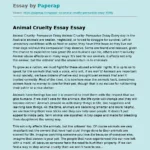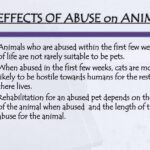In an era marked by increasing awareness regarding the ethical considerations surrounding animal welfare, the roles played by various animal rights organizations have come under the spotlight. Among these groups, one stands out as particularly instrumental in shaping public discourse on animal cruelty: the Humane Society of the United States (HSUS). This organization has amassed a significant following, galvanizing a movement that seeks to end suffering for animals across various contexts. But what exactly encapsulates the mission of HSUS, and how does it contribute to the broader animal rights landscape? Let’s delve deeper into the inception, purpose, and impact of this leading organization and explore others that share similar goals.
The acronym HSUS is synonymous with a relentless commitment to animal welfare and the promotion of humane treatment across various sectors. Founded in 1954, the organization initially focused on legislative reforms, but its mission has since expanded exponentially. Today, HSUS engages in advocacy, education, rescue operations, and welfare initiatives aimed at ending captivity and promoting a shift from exploitation to compassion.
Understanding HSUS’s mission requires a brief exploration of its foundational goals. Primarily, the organization strives to advocate for reforms in animal cruelty laws, combat puppy mills, and champion the ethical treatment of farm animals. As the organization continues to evolve, its commitment to addressing systemic issues tied to animal cruelty has intensified, underscoring the interconnectedness of public health, environmental sustainability, and animal welfare.
The crusade against animal cruelty extends beyond HSUS. Numerous organizations exhibit a diverse array of strategies, philosophies, and methodologies. For example, People for the Ethical Treatment of Animals (PETA) utilizes provocative campaigns to challenge societal norms surrounding animal rights. PETA arguably adopts a more radical approach, advocating for veganism while highlighting the mistreatment prevalent within various industries, from fashion to entertainment.
In tandem with HSUS and PETA, groups like the Animal Legal Defense Fund (ALDF) emphasize legal avenues for animal protection. ALDF is pioneering new laws that recognize animals as sentient beings deserving of legal considerations. Their work represents a paradigm shift in animal rights, advocating for the integration of animals into the fabric of our legal systems as beings worthy of rights.
While organizations like HSUS and PETA predominantly advocate for reform and raising awareness, others adopt hands-on approaches in rescue and rehabilitation. The Best Friends Animal Society focuses on providing shelter and safety for homeless pets while highlighting the importance of spaying and neutering to mitigate overpopulation issues. Their work offers a compelling narrative on how direct intervention can lead to substantive improvements in the lives of animals.
Moreover, international organizations such as World Animal Protection engage on a global scale, tackling issues ranging from factory farming to the wildlife trade. They emphasize a unified vision for a world where animals are free from suffering. Their multi-faceted approach entails working with governments, businesses, and local communities to enact change, illustrating the importance of collaboration in addressing the pervasive issue of animal cruelty.
The collective efforts of these organizations indeed encapsulate a broader shift in perspective regarding animal rights. By combining legal advocacy, grassroots activism, educational outreach, and rescue operations, they collectively forge a path toward a more humane society. It is imperative to recognize the role of public policy in catalyzing change. Advocacy surrounding laws such as the Animal Welfare Act in the United States illustrates how legislative measures can serve as bulwarks against cruelty, further emphasizing the need for sustained activism.
However, deciphering the acronyms and missions of animal rights organizations can sometimes be a challenge. Beyond HSUS and PETA, consider groups such as the Farm Sanctuary, which works specifically to rescue and rehabilitate farm animals, advocating for systemic changes in agricultural practices. Similarly, the American Society for the Prevention of Cruelty to Animals (ASPCA) has made considerable strides in preventing animal abuse through education, advocacy, and their comprehensive animal cruelty investigations.
This multitude of organizations each brings unique perspectives to the conversation surrounding animal welfare, yet they are often unified by common goals: eradicating cruelty, fostering compassion, and raising awareness. As the public increasingly recognizes the plight of animals raised in oppressive environments, these organizations play a pivotal role in serving both as a voice and a platform. They entice society to reflect on its values and confront the uncomfortable truths surrounding animal suffering and systemic complicity.
Thus, the question remains—how can you contribute to the movement against animal cruelty? Engaging with these organizations through volunteering, donations, or advocacy can serve as vital support. Every action, no matter how small, contributes to a larger tapestry of change. Educational initiatives, fostering dialogue about ethical consumption, and advocating for systemic reform are all essential components of progress.
In conclusion, the landscape of animal rights organizations is as varied as the issues they address. HSUS may dominate the conversation alongside PETA, but a plethora of organizations exists, each with their own strategies and methodologies. Understanding the nuances of these acronyms reveals a rich tapestry of activism dedicated to ushering in an era of empathy toward all living beings. The fight against animal cruelty is ongoing, and it beckons each of us to take a stand, examine our choices, and consider the vital ethical implications entwined within our everyday lives.








